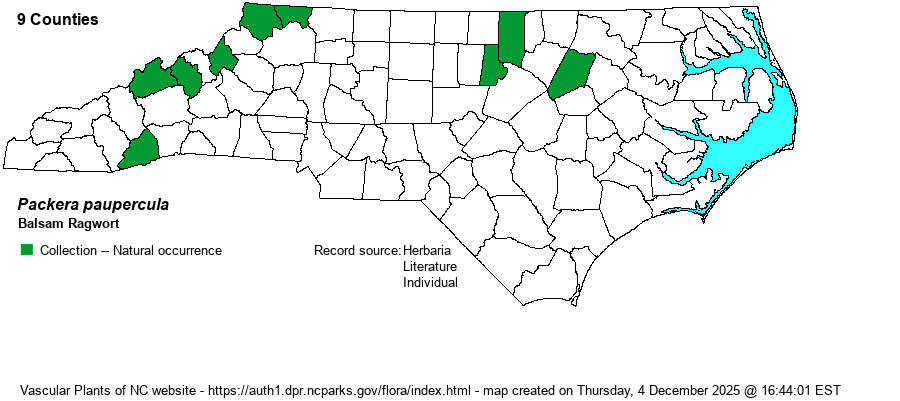| Author | (Michaux) A. Love & D. Love | |
| Distribution | This species has a complex history of taxonomic names and splits -- see Taxonomic Comments. Though var. paupercula appears to represent most of the specimen records, var. appalachiana is limited to the northern Mountains. Study of specimen labels is quite confusing, and it is suspected that some are incorrectly assigned to species (i.e., may be P. crawfordii if not also P. anonyma) and variety. Specimens from Alleghany, Ashe, and Avery counties (all at NCSC) need careful ID check. Currently, this species seems to be limited to the northeastern Piedmont and in the Mountains, with the gap in most of the Piedmont perhaps real (though there are records for VA's southwestern Piedmont). Also, the NCNHP database lists a number of reports from the South Mountains in the southwestern Piedmont, from four additional counties. However, these are all sight reports from the same observer; until specimens are made and carefully examined from this area, the editors cannot accept these reports.
Lab. to AK, south to northwestern FL, AL, and OR. | |
| Abundance | Very rare to rare in the Mountains and the northeastern Piedmont, with probably less than 10 total valid records -- plus a number of other unvalidated reports. The var. appalachiana is State Threatened, whereas the var. paupercula is State Special Concern. The NCNHP has State Ranks of S1 and S1?, respectively, for these taxa, and thus the overall State Rank for the species is likely best as S1S2. | |
| Habitat | Packera paupercula is a species of dry barren sites, generally over mafic rocks, such as in glades, thickets, fields, and open woodlands. The confusingly similar P. crawfordii is a species of damp ground, of bogs and fens in the mountains and of savannas in the lower Coastal Plain; however, as with P. paupercula, it also favors high pH soil. |
| Phenology | Flowering and fruiting April-May. | |
| Identification | Unlike some of our ragworts, Balsam Ragwort's basal leaves are not cut or dissected, but narrowly elliptical and with small teeth. Stem leaves are cut pinnately as in other species. Roundleaf Ragwort (P. obovata) has distinctly broader basal leaves and which are broadest toward the tip. The var. applachiana has permanent woolly hairs on mature leaves (vs. glabrous or glabrate). The more widespread var. paupercula is glabrate when blooming, and can be separated from the very common P. anonyma by having only 5-20 heads (vs. 20-100 in P. anonyma) and smaller basal leaves. From the similar P. crawfordii, Balsam Ragwort (nominate taxon) has only 3-10 teeth per margin (vs. 11-25 teeth), plants 6-12 inches tall (vs. 1-1.5 feet tall), and stem leaves unlobed (vs. pinnatifid divided). Some of the specimen or sight report issues involve "runt" individuals of P. anonyma; as this species is so common, it is expected that some plants or populations growing in quite dry places can be stunted and with fewer heads and smaller leaves. Be very careful when identifying the rare Balsam Ragwort, and make sure you have a specimen or two to back up your claim. | |
| Taxonomic Comments | The former Senecio pauperculus has been moved to Packera paupercula, but has been split out into two species -- Packera crawfordii and P. paupercula (see Weakley [2018]). Some references split it into two varieties -- var. appalachiana and var. paupercula.
| |
| Other Common Name(s) | Balsam Groundsel. This name seems more often in use than is Balsam Ragwort. However, "ragwort" is the general group name for Packera, and every effort should be made to name a species as "xxxxx Ragwort". | |
| State Rank | S1 [S1S2] | |
| Global Rank | G5 | |
| State Status | [T,SC-V] | |
| US Status | | |
| USACE-agcp | FACW link |
| USACE-emp | FAC link |

